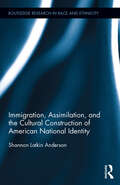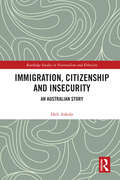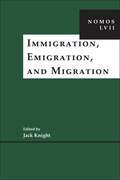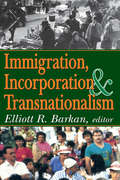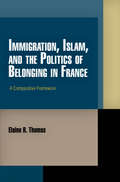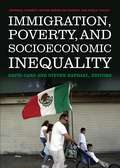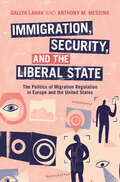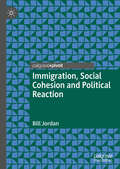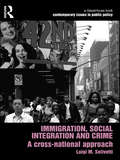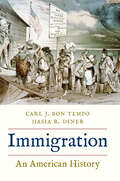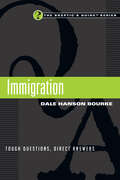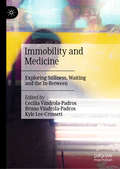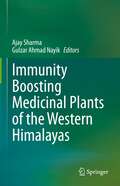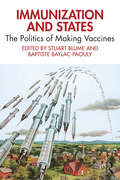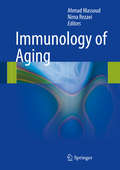- Table View
- List View
Immigration, Assimilation, and the Cultural Construction of American National Identity (Routledge Research in Race and Ethnicity)
by Shannon Latkin AndersonOver the course of the 20th century, there have been three primary narratives of American national identity: the melting pot, Anglo-Protestantism, and cultural pluralism/multi-culturalism. This book offers a social and historical perspective on what shaped each of these imaginings, when each came to the fore, and which appear especially relevant early in the 21st century. These issues are addressed by looking at the United States and elite notions of the meaning of America across the 20th century, centering on the work of Horace Kallen, Nathan Glazer and Daniel Patrick Moynihan, and Samuel P. Huntington. Four structural areas are examined in each period: the economy, involvement in foreign affairs, social movements, and immigration. What emerges is a narrative arc whereby immigration plays a clear and crucial role in shaping cultural stories of national identity as written by elite scholars. These stories are represented in writings throughout all three periods, and in such work we see the intellectual development and specification of the dominant narratives, along with challenges to each. Important conclusions include a keen reminder that identities are often formed along borders both external and internal, that structure and culture operate dialectically, and that national identity is hardly a monolithic, static formation.
Immigration, Citizenship and Insecurity: An Australian Story (Routledge Studies in Nationalism and Ethnicity)
by Heli AskolaImmigration, Citizenship and Insecurity: An Australian Story explores how Australia’s policies on migration and nationality have shaped citizenship and social inclusion.The book examines the historical and contemporary intersections of citizenship, migration and insecurity, analysing key issues such as the prioritisation of economic utility in migration policy, cultural expectations placed on newcomers and the role of migrants in political debate. It critically assesses Australia’s responses to challenges such as demographic ageing, cultural diversity and erosion of political authority. The impact of emergency measures during the COVID-19 pandemic is also explored, revealing the fragility of citizenship protections in times of crisis.This book is an essential resource for scholars, policy-makers and professionals in migration studies, political science and public policy, as well as anyone interested in the evolving dynamics of citizenship and migration in Australia and beyond.
Immigration, Emigration, and Migration: NOMOS LVII (NOMOS - American Society for Political and Legal Philosophy #15)
by Jack KnightImmigration, Emigration and Migration consists of essays written by distinguished scholars across the fields of law, political science, and philosophy that examine questions of travel and migration across national borders. Questions of immigration and border enforcement practices are particularly salient in contemporary public discourse, and examinations of policy and practice bring forth new philosophical quandaries. Why the common assumption that each country has the right to control its own borders? How are laws that restrict or regulate migration created and justified? Why has the criminalization of migration increased? How can migration be better considered through the point of view of the migrants themselves? What are the differences in international and national institutional migratory policy? The volume explores questions of border control and enforcement, criminalization of borders, and how to address current debates and changes in regards to migration and immigration. The intersection of analysis and prescription provides both an assessment of current forms of thought or regulation and suggestion of alterations to address the flaws or failures of present approaches. The eight essays in this volume reflect a variety of considerations and explorations across interdisciplinary lines, and provide a new and thought-provoking discussion of policy, practice, and philosophy of migratory and border practices.
Immigration, Ethnicity, and National Identity in Brazil, 1808 to the Present
by Jeffrey LesserImmigration, Ethnicity, and National Identity in Brazil, 1808 to the Present examines the immigration to Brazil of millions of Europeans, Asians, and Middle Easterners beginning in the nineteenth century. Jeffrey Lesser analyzes how these newcomers and their descendents adapted to their new country and how national identity was formed as they became Brazilians along with their children and grandchildren. Lesser argues that immigration cannot be divorced from broader patterns of Brazilian race relations, as most immigrants settled in the decades surrounding the final abolition of slavery in 1888 and their experiences were deeply conditioned by ideas of race and ethnicity formed long before their arrival. This broad exploration of the relationships between immigration, ethnicity, and nation allows for analysis of one of the most vexing areas of Brazilian study: identity.
Immigration, Incorporation and Transnationalism
by Elliott R. BarkanImmigration, Incorporation and Transition is an intriguing collection of articles and essays. It was developed to commemorate the twenty-fi fth anniversary of The Journal of American Ethnic History. Its purpose, like that of the Immigration and Ethnic History Society, is to integrate interdisciplinary perspectives and exciting new scholarship on important themes and issues related to immigration and ethnic history.
Immigration, Islam, and the Politics of Belonging in France: A Comparative Framework (Pennsylvania Studies in Human Rights)
by Elaine R. ThomasOver the past three decades, neither France's treatment of Muslims nor changes in French, British, and German immigration laws have confirmed multiculturalist hopes or postnationalist expectations. Yet analyses positing unified national models also fall short in explaining contemporary issues of national and cultural identity. Immigration, Islam, and the Politics of Belonging in France: A Comparative Framework presents a more productive, multifaceted view of citizenship and nationality.Political scientist Elaine R. Thomas casts new light on recent conflicts over citizenship and national identity in France, as well as such contentious policies as laws restricting Muslim headscarves. Drawing on key methods and insights of ordinary language philosophers from Austin to Wittgenstein, Thomas looks at parliamentary debates, print journalism, radio and television transcripts, official government reports, legislation, and other primary sources related to the rights and status of immigrants and their descendants. Her analysis of French discourse shows how political strategies and varied ideas of membership have intertwined in France since the late 1970s. Thomas tracks the crystallization of a restrictive but apparently consensual interpretation of French republicanism, arguing that its ideals are increasingly strained, even as they remain politically powerful. Thomas also examines issues of Islam, immigration, and culture in other settings, including Britain and Germany.Immigration, Islam, and the Politics of Belonging in France gives scholarly researchers, political observers, and human rights advocates tools for better characterizing and comparing the theoretical stakes of immigration and integration and advances our understanding of an increasingly significant aspect of ethnic and religious politics in France, Europe, and beyond.
Immigration, Popular Culture, and the Re-routing of European Muslim Identity
by Lara N. Dotson-RentaThrough readings of postcolonial theory and examination of post-9/11 novels, film, and hip-hop music, this book studies how North African immigrants to Spain translate and transfer cultural and political memory from one land to another.
Immigration, Poverty, and Socioeconomic Inequality
by David Card Steven RaphaelThe rapid rise in the proportion of foreign-born residents in the United States since the mid-1960s is one of the most important demographic events of the past fifty years. The increase in immigration, especially among the less-skilled and less-educated, has prompted fears that the newcomers may have depressed the wages and employment of the native-born, burdened state and local budgets, and slowed the U.S. economy as a whole. Would the poverty rate be lower in the absence of immigration? How does the undocumented status of an increasing segment of the foreign-born population impact wages in the United States? In Immigration, Poverty, and Socioeconomic Inequality, noted labor economists David Card and Steven Raphael and an interdisciplinary team of scholars provide a comprehensive assessment of the costs and benefits of the latest era of immigration to the United States Immigration, Poverty, and Socioeconomic Inequality rigorously explores shifts in population trends, labor market competition, and socioeconomic segregation to investigate how the recent rise in immigration affects economic disadvantage in the United States. Giovanni Peri analyzes the changing skill composition of immigrants to the United States over the past two decades to assess their impact on the labor market outcomes of native-born workers. Despite concerns over labor market competition, he shows that the overall effect has been benign for most native groups. Moreover, immigration appears to have had negligible impacts on native poverty rates. Ethan Lewis examines whether differences in English proficiency explain this lack of competition between immigrant and native-born workers. He finds that parallel Spanish-speaking labor markets emerge in areas where Spanish speakers are sufficiently numerous, thereby limiting the impact of immigration on the wages of native-born residents. While the increase in the number of immigrants may not necessarily hurt the job prospects of native-born workers, low-skilled migration appears to suppress the wages of immigrants themselves. Michael Stoll shows that linguistic isolation and residential crowding in specific metropolitan areas has contributed to high poverty rates among immigrants. Have these economic disadvantages among low-skilled immigrants increased their dependence on the U.S. social safety net? Marianne Bitler and Hilary Hoynes analyze the consequences of welfare reform, which limited eligibility for major cash assistance programs. Their analysis documents sizable declines in program participation for foreign-born families since the 1990s and suggests that the safety net has become less effective in lowering child poverty among immigrant households. As the debate over immigration reform reemerges on the national agenda, Immigration, Poverty, and Socioeconomic Inequality provides a timely and authoritative review of the immigrant experience in the United States. With its wealth of data and intriguing hypotheses, the volume is an essential addition to the field of immigration studies. A Volume in the National Poverty Center Series on Poverty and Public Policy
Immigration, Security, and the Liberal State: The Politics Of Migration Regulation In Europe And The United States
by Gallya Lahav Anthony M. MessinaImmigration, Social Cohesion and Political Reaction
by Bill JordanThis book addresses the challenge for social integration posed by immigration into Western liberal democracies. Movement of people, goods and money across borders has increased in recent decades – the phenomenon known as globalisation. But it has been the migration of refugees from civil wars in the Middle East which has most transformed the political life of European societies, causing the decline in support for the traditional conservative and social democratic parties. It has triggered nationalistic mobilisations and authoritarian regimes, as well as attempts to improved integration in societies. The coronavirus pandemic has added a dimension to these processes, but also opened up new possibilities for transformation.
Immigration, Social Integration and Crime: A Cross-National Approach (Contemporary Issues in Public Policy)
by Luigi M. SolivettiThe problem of social control has constituted the acid test for the entire issue of immigration and integration. But whilst recent studies show that the crime rate for non-nationals is three, four or more, times higher than that of the country’s 'own' citizens, academic interest in these statistics has been inhibited by the political difficulties they raise. Immigration, Social Integration and Crime addresses this issue directly. Providing a thorough analysis of immigration and crime rates in all of the main European countries, as well as examining the situation in the US, Luigi M. Solivetti concludes that the widespread notion that a large non-national population produces high crime rates must be rejected. Noting the undeniably substantial, but significantly variable, contribution of non-nationals to crime statistics in Western Europe, he nevertheless goes on to analyze and explain the factors that influence the relationship between immigration and crime. It is the characteristics of the 'host' countries that are shown to be significantly associated with non-nationals’ integration and, ultimately, their involvement in crime. In particular, Solivetti concludes, it is 'social capital' in the host societies – comprized of features such as education, transparency, and openness – that plays a key role in non-nationals’ integration chances, and so in their likelihood to commit crime. Supported by extensive empirical data and statistical analysis, Immigration, Social Integration and Crime provides an invaluable contribution to one of the most pressing social and political debates – in Europe, and elsewhere.
Immigration: An American History
by Hasia R. Diner Carl J. Bon TempoA sweeping narrative history of American immigration from the colonial period to the present “A masterly historical synthesis, full of wonderful detail and beautifully written, that brings fresh insights to the story of how immigrants were drawn to and settled in America over the centuries.”—Nancy Foner, author of One Quarter of the Nation The history of the United States has been shaped by immigration. Historians Carl J. Bon Tempo and Hasia R. Diner provide a sweeping historical narrative told through the lives and words of the quite ordinary people who did nothing less than make the nation. Drawn from stories spanning the colonial period to the present, Bon Tempo and Diner detail the experiences of people from Europe, Asia, Africa, and the Americas. They explore the many themes of American immigration scholarship, including the contexts and motivations for migration, settlement patterns, work, family, racism, and nativism, against the background of immigration law and policy. Taking a global approach that considers economic and personal factors in both the sending and receiving societies, the authors pay close attention to how immigration has been shaped by the state response to its promises and challenges.
Immigration: Opposing Viewpoints
by Mary WilliamsExamines the issues pertaining to legal and illegal immigration: Should Immigration Be Restricted? Is Immigration a Serious Problem? How Should the United States Address Illegal Immigration? How Should U.S. Immigration Policy Be Reformed?
Immigration: Tough Questions, Direct Answers (The Skeptic's Guide Series)
by Dale Hanson BourkeHow can we be sure terrorists aren't entering our country? What does it mean to be a citizen? Do immigrants help or hurt the economy? What's wrong with calling someone an illegal immigrant? In this Skeptic's Guide™ Dale Hanson Bourke sheds light on key terms and concepts, historical events and current concerns that drive the immigration debate. Such a complex issue offers no easy answers, but with charts and photos, facts and quotes, this dynamic guide sheds light without adding heat to the most important questions—a hallmark of the Skeptic's Guide series, making it a valuable resource for individuals and groups.
Immobility and Medicine: Exploring Stillness, Waiting and the In-Between
by Cecilia Vindrola-Padros Bruno Vindrola-Padros Kyle Lee-CrossettRecent work in the mobilities literature has highlighted the importance of thinking about mobility and immobility as a continuum, where movement intersects with processes that might entail episodes of transition, waiting, emptiness, and fixity. This focus on stillness, things that are stuck, incomplete or in a state of transition can point to new theoretical, methodological and practical dimensions in social studies of medicine. This edited volume brings the concept of immobility to the forefront of social studies of medicine to explore how immobility shapes processes of medical care and the theoretical and methodological challenges of studying immobility in medical contexts. The authors in this volume draw from a wide range of case studies across the globe to make contributions to our current understanding of health, illness and medicine, mobilities and immobilities.Chapter 2 “Lists in Flux, Lives on Hold? Technologies of Waiting in Liver Transplant Medicine” is available open access under a Creative Commons Attribution 4.0 International License via link.springer.com.
Immortal, Invisible: Lesbians and the Moving Image
by Tamsin WiltonImmortal, Invisible: Lesbians and the Moving Image is the first collection to bring together leading film-makers, academics and activists to discuss films by, for and about lesbians and queer women. The contributors debate the practice of lesbian and queer film-making, from the queer cinema of Monika Treut to the work of lesbian film-makers Andrea Weiss and Greta Schiller. They explore the pleasures and problems of lesbian spectatorship, both in mainstream Hollywood films including Aliens and Red Sonja, and in independent cinema from She Must be Seeing Things to Salmonberries and Desert Hearts. The authors tackle tricky questions: can a film such as Strictly Ballroom be both pleasurably camp and heterosexist? Is it ok to drool over dyke icons like Sigourney Weaver and kd lang? What makes a film lesbian, or queer, or even post-queer? What about showing sex on screen? And why do lesbian screen romances hardly ever have happy endings? Immortal, Invisible is splendidly illustrated with a selection of images from film and television texts.
Immortality, Inc.: Renegade Science, Silicon Valley Billions, and the Quest to Live Forever
by Chip WalterThis gripping narrative explores today's scientific pursuit of immortality, with exclusive visits inside Silicon Valley labs and interviews with the visionaries who believe we will soon crack into the aging process and cure death.We live in an age when billionaires are betting their fortunes on laboratory advances to prove aging unnecessary and death a disease that can be cured. Researchers are delving into the mysteries of stem cells and the human genome, discovering what it means to grow old and how to keep those processes from happening. This isn't science fiction; it's real, it's serious, and it's on track to revolutionize our definitions of life and mortality.In Immortality, Inc., veteran science journalist Chip Walter gains exclusive access to the champions of this radical cause, delivering a book that brings together for the first time the visions of molecular biologist and Apple chairman Arthur Levinson, genomics entrepreneur Craig Venter, futurist Ray Kurzweil, rejuvenation trailblazer Aubrey de Grey, and stem cell expert Robert Hariri. Along the way, Walter weaves in fascinating conversations about life, death, aging, and the future of the human race.
Immunitas: The Protection And Negation Of Life
by Roberto EspositoThis book by Roberto Esposito - a leading Italian political philosopher - is a highly original exploration of the relationship between human bodies and societies. The original function of law, even before it was codified, was to preserve peaceful cohabitation between people who were exposed to the risk of destructive conflict. Just as the human body's immune system protects the organism from deadly incursions by viruses and other threats, law also ensures the survival of the community in a life-threatening situation. It protects and prolongs life. But the function of law as a form of immunization points to a more disturbing consideration. Like the individual body, the collective body can be immunized from the perceived danger only by allowing a little of what threatens it to enter its protective boundaries. This means that in order to escape the clutches of death, life is forced to incorporate within itself the lethal principle. Starting from this reflection on the nature of immunization, Esposito offers a wide-ranging analysis of contemporary biopolitics. Never more than at present has the demand for immunization come to characterize all aspects of our existence. The more we feel at risk of being infiltrated and infected by foreign elements, the more the life of the individual and society closes off within its protective boundaries, forcing us to choose between a self-destructive outcome and a more radical alternative based on a new conception of community.
Immunity Boosting Medicinal Plants of the Western Himalayas
by Ajay Sharma Gulzar Ahmad NayikThis book presents a comprehensive guide to traditional immunity-boosting medicinal plants of the Himalayas, their traditional uses, phytochemistry, pharmacology, diversity, conversation, biotechnology, toxicology, as well as future prospective. All the chapters cover the latest advances in ethnobotany, phytochemistry, biochemistry, and biotechnology. The book offers a valuable asset for researchers and graduate students of chemistry, botany, biotechnology, microbiology, and the pharmaceutical sciences. The main purpose of the present book is to draw on the rich culture, folklore, and biodiversity of immunity-boosting medicinal plants of the Western Himalayas, with particular emphasis on the Indian Trans-Himalayan and Western Himalayan region. All the plants included in the present book are extensively used by the local tribes and people for their health-promoting properties from ancient times. This book will be a substantial contribution to the knowledge of the region and the country. Also, the book will be very useful to scientists, graduates, and undergraduates, along with researchers in the fields of natural products, herbal medicines, ethnobotany, pharmacology, chemistry, and biology. Further, it is an equally significant resource for a person working in different traditional medicinal systems; doctors (especially those engaged in Ayurveda, Chinese traditional medicinal system, Amchi, and allopathy); the pharmaceutical industry (for drug design and synthesis); biochemistry and biotechnology sciences; and the agricultural sciences.
Immunization and States: The Politics of Making Vaccines
by Stuart BlumeGlobally, there has been a move away from national public sector vaccine development over the past 30 years. Immunization and States: The Politics of Making Vaccines explores vaccine geopolitics, analyzing why, and how this move happened, before looking at the ramifications in the context of Covid-19. This unique book uses eight country studies – looking at Croatia, India, Iran, the Netherlands, Romania, Serbia, Spain, and Sweden – to explore the role of public sector vaccine institutes, past and present. Raising questions about national sovereignty, the erosion of multilateralism, and geopolitics, it also contributes to debates around public interest and privatization in the health sector. An extended introduction sets the chapters in an international context, whilst the epilogue looks forward to the future of vaccine development and production. This is an important book for students, scholars, and practitioners with an interest in vaccine development from a range of fields, including public health, medicine, science and technology studies, history of medicine, politics, international relations, and the sociology of health and illness.
Immunology of Aging
by Nima Rezaei Ahmad MassoudThe rapidity of scientific progress over the last few years guarantees the utility of this new collection of state-of-the-art reviews on the immunology of aging, which is the result of extensive collaboration of more than sixty of the greatest thinkers and scholars in the field, in cooperation with a number of junior colleagues. The book summarizes current knowledge on the cellular and molecular aspects of the aging immune system and their clinical relevance, providing insights into the effects of the aging process on susceptibilities to those diseases most common among elders. The retrieval strategies used to slow down the decline in the immune system in the elderly are another subject detailed extensively. By providing a broad overview of immunosenescence and its consequences, as well as their potential modulation, this book will fill a gap in a timely manner. It will be of value to all immunologists, whether novice or experienced, as well as geriatricians and epidemiologists.
Impact
by Lawrence M. FriedmanUnder what conditions are laws and rules effective? Lawrence M. Friedman gathers findings from many disciplines into one overarching analysis and lays the groundwork for a cohesive body of work in "impact studies." He examines the importance of communication on the part of lawgivers and the nuances of motive among those subject to the law.
Impact 2: Workbook
by Katherine StannettImpact helps teenage learners to better understand themselves, each other, and the world they live in. By encouraging self-expression, global citizenship, and active participation, impact motivates students to explore who they are and who they want to be, all while learning english.
Impact 3: Workbook
by Diane PinkleyA five-level series that encourages self-expression, global citizenship, and active participation in the classroom through cross-curricular topics and stories from National Geographic Explorers.
